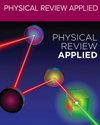Topological logical elements based on defect-mediated sound-wave manipulation
IF 4.4
2区 物理与天体物理
Q2 PHYSICS, APPLIED
引用次数: 0
Abstract
Growing interest in acoustic topological insulators arises from their robust edge states, which are resistant to defects and backscattering. Traditionally, the edge states of topological insulators are believed to be nearly immune to subwavelength-sized defects. As a result, there have been few studies focusing on utilizing defects to enhance wave control. Here, we investigate the impact of introducing periodic defects into acoustic pseudospin systems on the band structures and extend our analysis to nonperiodic structures. We discover that even a single subwavelength defect can significantly affect the topological boundary states, providing a platform for controlling and switching pseudospin edge states using defects. Expanding on this discovery, we develop a broadband topological sound switch (TSS) that achieves a high transmission ratio before and after switching by simply rotating a single scatterer. Additionally, we design three topological logic gates based on this TSS and experimentally verify their functionality. Our theory and experiments demonstrate that the spatial arrangement of defects can serve as a means of manipulating sound waves, potentially advancing acoustic computing and information processing.

基于缺陷介导声波操纵的拓扑逻辑元件
人们对声学拓扑绝缘体的兴趣与日俱增,因为它们具有坚固的边缘态,能够抵御缺陷和反向散射。传统上,人们认为拓扑绝缘体的边缘状态几乎不受亚波长尺寸缺陷的影响。因此,很少有研究关注利用缺陷来增强波控制。在这里,我们研究了将周期性缺陷引入声学伪空间系统对带状结构的影响,并将分析扩展到非周期性结构。我们发现,即使是单个亚波长缺陷也能显著影响拓扑边界态,从而为利用缺陷控制和切换伪自旋边缘态提供了一个平台。基于这一发现,我们开发了一种宽带拓扑声开关(TSS),只需旋转单个散射体,就能在开关前后实现高传输比。此外,我们还基于该拓扑开关设计了三个拓扑逻辑门,并通过实验验证了它们的功能。我们的理论和实验证明,缺陷的空间排列可以作为操纵声波的一种手段,从而有可能推动声学计算和信息处理的发展。
本文章由计算机程序翻译,如有差异,请以英文原文为准。
求助全文
约1分钟内获得全文
求助全文
来源期刊

Physical Review Applied
PHYSICS, APPLIED-
CiteScore
7.80
自引率
8.70%
发文量
760
审稿时长
2.5 months
期刊介绍:
Physical Review Applied (PRApplied) publishes high-quality papers that bridge the gap between engineering and physics, and between current and future technologies. PRApplied welcomes papers from both the engineering and physics communities, in academia and industry.
PRApplied focuses on topics including:
Biophysics, bioelectronics, and biomedical engineering,
Device physics,
Electronics,
Technology to harvest, store, and transmit energy, focusing on renewable energy technologies,
Geophysics and space science,
Industrial physics,
Magnetism and spintronics,
Metamaterials,
Microfluidics,
Nonlinear dynamics and pattern formation in natural or manufactured systems,
Nanoscience and nanotechnology,
Optics, optoelectronics, photonics, and photonic devices,
Quantum information processing, both algorithms and hardware,
Soft matter physics, including granular and complex fluids and active matter.
 求助内容:
求助内容: 应助结果提醒方式:
应助结果提醒方式:


